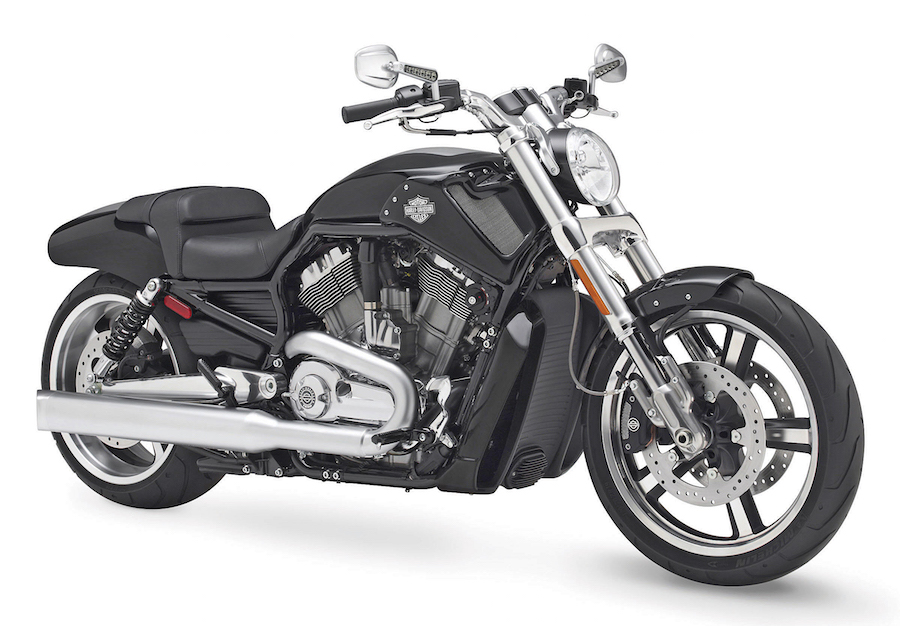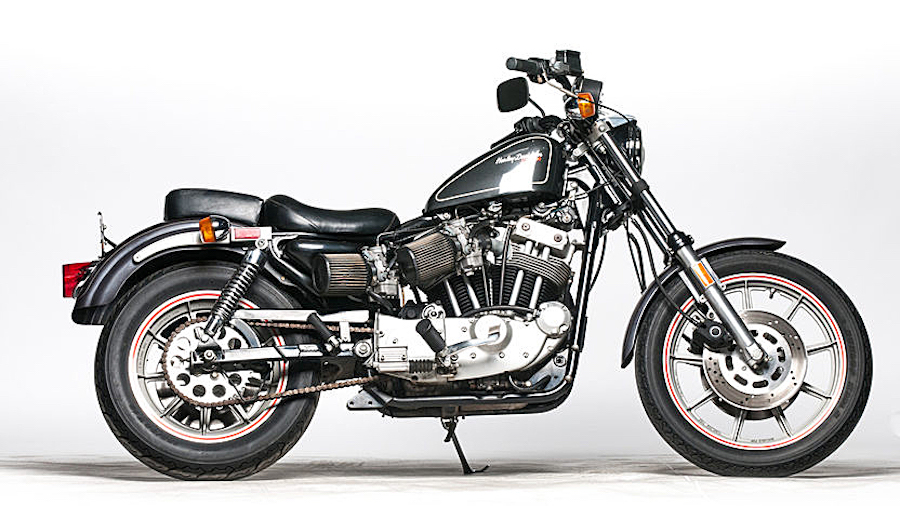Harley-Davidson stormed into the new millennium with a radical new model almost ready for release. The subsequent 2001 launch of the new VRSC (V-twin Racing Street Custom) V-Rod left many observers open-mouthed.
Suddenly there was a Harley that owed little to the brand’s traditional Big Twin cruisers. Long and low and cleanly styled, it was a gleaming combination of chrome, polished alloy and silver paint. Resembling alloy, the perimeter-frame was fabricated from steel tubing – hydro-formed (filled with water during bending) to ensure smooth bends. The V-Rod’s liquid-cooled, 60-degree, DOHC, four-valve, 1130cc Revolution engine represented a heroic leap away from the Milwaukee factory’s air-cooled, 45-degree, two-valve motors. The scale of the exercise was underlined by H-D’s use of German design expertise – Porsche for engine-design detail and Getrag for gearbox detail. Also new was gear primary-drive replacing H-D’s trademark primary-chain. It rolled on Fat Boy inspired disc wheels suspended on a raked-out 49mm fork and a lovely cast-alloy swingarm supported by twin shocks.
During the V-Rod’s subsequent 16-year model run, a range of versions appeared generally distinguished by cosmetic and chassis detail differences. Significant changes were the engine displacement boost to 1250cc in 2008, with power increasing from 86kW to 92kW, and an increase in rear tyre width from 180mm to 240mm (on some model derivatives as early as 2007, later for all models).
Pretty much regardless of the model you choose there’s definitely a dragstrip flavour to the V-Rod experience as you settle into the low and comfortable seat, gazing over the wide ’bars and the raked-out front end of the long, low chassis. Versions with forward-mount footrests can require a big stretch for shorter folk.
Its weight (typically around 270kg-dry) is carried low enough to not be a real issue.
The powertrain’s design sophistication is immediately obvious on the road. The hi-tech 60-degree motor is way smoother than typical Harley V-twins. The EFI’s fuelling is spot on. Vibration is minimal. Its broad spread of serious torque is accessed happily through the five-speed gearbox with progressive responses from throttle and clutch alike. While clutch action is fairly heavy the gearshift is quite slick and accurate.
Suspension performance and handling deserves praise for dealing with bumps effectively while delivering high-speed stability and accurate cornering. The qualifications are that it tends to flop into low-speed corners thanks to the 38-degree fork rake. Predictably the long (1715mm) wheelbase enhances stability while slowing steering responses (as does the 240mm rear tyre on later models). Although cornering clearance beats usual cruiser standards, it nevertheless limits lean angles and cornering speeds, particularly on fast right-handers on early models when you deck the lower muffler.
Engine performance around 3000rpm in traffic is smooth and relaxed before you break free and ride the rising torque-wave toward 5000rpm. Then, about where most H-D ‘Big Twins’ are calling it quits, the V-Rod surges urgently on in a spine-tingling rush toward the 9000rpm rev-limiter. In this mode you’re enjoying serious performance (from both 1130cc and 1250cc versions) – no surprise given that the Revolution engines’ respectable power outputs are built on mountains of torque.
Three 292mm four-pot brake-discs rein in the bike’s performance effectively – you use the back brake quite a bit, even on a ‘muscle’ cruiser.
The 14-litre underseat-mounted tank on early models limits the safe touring range to 200-220km. The 19-litre tank of later models is an improvement.
Obviously the route H-D followed to come up with this big-bore bitumen-burner produced a result closer to a Yamaha VMax than a Suzuki Hayabusa. Although dragstrip-style action does come naturally to a V-Rod, it’s a decent weekend scratcher and a good commuter. It’s also a showcase for engineering excellence and reliability and, make no mistake, this Harley-Davidson is a sophisticated high-performance motorcycle.
- Different in design from other Harleys, V-Rods were also built in a different location – not Milwaukee, but Kansas City, Missouri.
- The V-Rod was the first Harley-Davidson to feature turn-signal lights incorporated into its mirrors.
- In 2006 a batch of over 600 dedicated competition models nicknamed ‘Destroyer’ was built for drag-strip use only.
- When engine capacity was increased from 1130cc to 1250cc in 2008, a slipper clutch was added to the drivetrain.

Building bricks
1957 XL Sportster introduced as the first compact OHV Harley aimed at countering the popularity of sporty 650cc Brit twins.

1983 XR1000 performance bike launched with engine derived from XR750 racebike.

1994 VR1000 road-going version of H-D’s VR1000 superbike contender launched in limited numbers for homologation purposes.

PRICE GUIDE
New price
$30,500 (2001)
$27,995 (2017)
Secondhand
$13,300 – 24,500
The low-down
What to look for
Excellent engineering and manufacturing quality contribute to the V-Rod’s remarkable reliability record. I’m unaware of any consistent issues beyond reports of some fuel-gauge malfunctions.
Drive-belts are apparently good for 160,000km but damage from trapped stones can cause premature failure, so check belt and pulley condition carefully.
Then it’s down to allowing for tyres, brake pads, steering head bearings and brake rotors that will soon need replacing.
Service history
A properly serviced V-Rod will be a trouble-free long-term proposition. Routine servicing can be done readily by DIY owners.
With valve shims instead of H-D’s usual hydraulic lifters, valve-clearance adjustments are costly. Not only must the camshafts come out, the engine has to be partly unbolted from its mountings and lowered to get access.
Service intervals are 8000km for oil and filter, 16,000km for spark-plugs and 24,000km for valve clearances.
Words Rob Blackbourn Photography AMCN Archive











